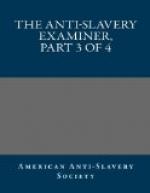EXTRACT OF A LETTER FROM MR. W. DUSTIN, a member of the Methodist Episcopal Church, and, when the letter was written, 1835, a student of Marietta College, Ohio.
“I find by looking over my journal that the murdering, which I spoke of yesterday, took place about the first of June, 1834.
“Without commenting upon this act of cruelty, or giving vent to my own feelings, I will simply give you a statement of the fact, as known from personal observation.
“Dr. K. a man of wealth, and a practising physician in the county of Yazoo, state of Mississippi, personally known to me, having lived in the same neighborhood more than twelve months, after having scourged one of his negroes for running away, declared with an oath, that if he ran away again, he would kill him. The negro, so soon as an opportunity offered, ran away again. He was caught and brought back. Again he was scourged, until his flesh, mangled and torn, and thick mingled with the clotted blood, rolled from his back. He became apparently insensible, and beneath the heaviest stroke would scarcely utter a groan. The master got tired, laid down his whip and nailed the negro’s ear to a tree; in this condition, nailed fast to the rugged wood, he remained all night!
“Suffice it to say, in the conclusion, that the next day he was found DEAD!
“Well, what did they do with the master? The sum total of it is this: he was taken before a magistrate and gave bonds, for his appearance at the next court. Well, to be sure he had plenty of cash, so he paid up his bonds and moved away, and there the matter ended.
“If the above fact will be of any service to you in exhibiting to the world the condition of the unfortunate negroes, you are at liberty to make use of it in any way you think best.
Yours, fraternally, M. DUSTIN.”
Mr. ALFRED WILKINSON, a member of the Baptist Church in Skeneateles, N.Y. and the assessor of that town, has furnished the following:
“I went down the Mississippi in December, 1838 and saw twelve of fourteen negroes punished on one plantation, by stretching them on a ladder and tying them to it; then stripping off their clothes, and whipping them on the naked flesh with a heavy whip, the lash seven or eight feet long: most of the strokes cut the skin. I understood they were whipped for not doing the tasks allotted to them.”
FROM THE PHILANTHROPIST, Cincinnati, Ohio, Feb. 26, 1839.
“A very intelligent lady the widow of a highly respectable preacher of the gospel of the Presbyterian Church, formerly a resident of a free state, and a colonizationist, and a strong antiabolitionist, who, although an enemy to slavery, was opposed to abolition on the ground that it was for carrying things too rapidly, and without regard to circumstances, and especially who believed that abolitionists exaggerated with regard to the evils of slavery, and used to say that such men ought to go to slave states and see for themselves, to be convinced that they did the slaveholders injustice, has gone and seen for herself. Hear her testimony.”




